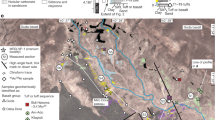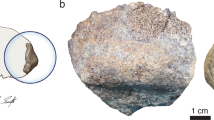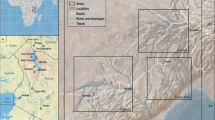Abstract
Remains of 13 early hominids have been found in the Laetolil Beds in northern Tanzania, 30 miles south of Olduvai Gorge. Potassium–argon dating of the fossiliferous deposits gives an upper limit averaging 3.59 Myr and a lower limit of 3.77 Myr. An extensive mammalian fauna is associated. The fossils occur in the upper 30 m of ash-fall and aeolian tuffs whose total measured thickness is 130 m.
This is a preview of subscription content, access via your institution
Access options
Subscribe to this journal
Receive 51 print issues and online access
$199.00 per year
only $3.90 per issue
Buy this article
- Purchase on Springer Link
- Instant access to full article PDF
Prices may be subject to local taxes which are calculated during checkout
Similar content being viewed by others
References
Weinert, H., Z. Morph. Anthrop., 42, 138–148 (1950).
Dietrich, W. O., Palaeontographica, 94 A, 43–133 (1942).
Maglio, V. J., Breviora, 336 (1969).
Kent, P. E., Geol. Mag., Lond., 78, 173–184 (1941).
Kohl-Larsen, L., Auf des Spuren des Vormenschen, 2, 379–381 (1943).
Pickering, R., Endulen, Quarter degree sheet 52 (Geological Survey in Tanzania, 1964).
Hay, R. L., Bull. geol. Soc. Am., 1281–1286 (1963).
Hay, R. L., Geology of the Olduvai Gorge (University of California Press, 1976).
Hopwood, A. T., in Olduvai Gorge (edit. by Leakey, L. S. B.), (Cambridge University Press, 1951).
Robinson, J. T., Transvaal Museum Mem., 9, 1 (1956).
Leakey, R. E. F., and Wood, B. A., Am. J. phys. Anthrop., 39, 355 (1973).
Leakey, R. E. F., and Wood, B. A., Am J. phys. Anthrop., 39, 355 (1974).
Leakey, R. E. F., Nature, 242, 170 (1972).
Leakey, L. S. B., Nature, 188, 1050 (1960).
Leakey, L. S. B., and Leakey, M. D., Nature, 202, 3 (1964).
Day, M. H., and Leakey, R. E. F., Am. J. phys. Anthrop., 41, 367 (1974).
Leakey, R. E. F., Nature, 248, 653 (1974).
Carney, J., Hill, A., Miller, J., and Walker, A., Nature, 230, 509 (1971).
Leakey, R. E. F., Mungai, J. M., and Walker, A. C., Am. J. phys. Anthrop., 36, 235 (1972).
Leakey, R. E. F., and Walker, A. C., Am. J. phys. Anthrop., 39, 205 (1973).
Tobias, P. V., Olduvai Gorge, 2 (Cambridge University Press, 1967).
Leakey, M. D., Clarke, R. J., and Leakey, L. S. B., Nature, 232, 308 (1971).
Johanson, D. C., and Taieb, M., Nature, 260, 293–297 (1976).
Author information
Authors and Affiliations
Rights and permissions
About this article
Cite this article
Leakey, M., Hay, R., Curtis, G. et al. Fossil hominids from the Laetolil Beds. Nature 262, 460–466 (1976). https://doi.org/10.1038/262460a0
Received:
Accepted:
Issue Date:
DOI: https://doi.org/10.1038/262460a0
This article is cited by
-
The Thorny Issue of African Porcupines: a New Mandible of Hystrix makapanensis from Olduvai Gorge (Tanzania) and Rediagnosis of the Species
Journal of Mammalian Evolution (2022)
-
A Newly Discovered Acheulean Assemblage in the Mbulu Plateau, Northern Tanzania
African Archaeological Review (2022)
-
Early humans far from the South African coast collected unusual objects
Nature (2021)
Comments
By submitting a comment you agree to abide by our Terms and Community Guidelines. If you find something abusive or that does not comply with our terms or guidelines please flag it as inappropriate.



